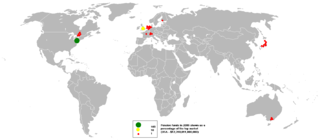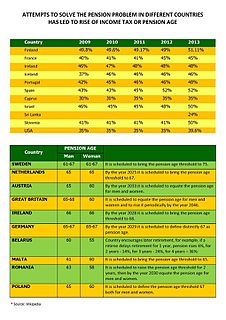Related Research Articles
In the United States, a 401(k) plan is the tax-qualified, defined-contribution pension account defined in subsection 401(k) of the Internal Revenue Code. Under the plan, retirement saving contributions are provided by an employer, deducted from the employee's paycheck before taxation, and limited to a maximum pre-tax annual contribution of $19,500.
A pension is a fund into which a sum of money is added during an employee's employment years and from which payments are drawn to support the person's retirement from work in the form of periodic payments. A pension may be a "defined benefit plan", where a fixed sum is paid regularly to a person, or a "defined contribution plan", under which a fixed sum is invested that then becomes available at retirement age. Pensions should not be confused with severance pay; the former is usually paid in regular installments for life after retirement, while the latter is typically paid as a fixed amount after involuntary termination of employment prior to retirement.

A pension fund, also known as a superannuation fund in some countries, is any plan, fund, or scheme which provides retirement income.
Self-insurance is a situation in which a person or business does not take out any third-party insurance, but rather a business that is liable for some risk, such as health costs, chooses to bear the risk itself rather than take out insurance through an insurance company.

The Employee Retirement Income Security Act of 1974 (ERISA) is a federal United States tax and labor law that establishes minimum standards for pension plans in private industry. It contains rules on the federal income tax effects of transactions associated with employee benefit plans. ERISA was enacted to protect the interests of employee benefit plan participants and their beneficiaries by:
A retirement plan is a financial arrangement designed to replace employment income upon retirement. These plans may be set up by employers, insurance companies, trade unions, the government, or other institutions. Congress has expressed a desire to encourage responsible retirement planning by granting favorable tax treatment to a wide variety of plans. Federal tax aspects of retirement plans in the United States are based on provisions of the Internal Revenue Code and the plans are regulated by the Department of Labor under the provisions of the Employee Retirement Income Security Act (ERISA).

The Pension Benefit Guaranty Corporation (PBGC) is a United States federally chartered corporation created by the Employee Retirement Income Security Act of 1974 (ERISA) to encourage the continuation and maintenance of voluntary private defined benefit pension plans, provide timely and uninterrupted payment of pension benefits, and keep pension insurance premiums at the lowest level necessary to carry out its operations. Subject to other statutory limitations, PBGC's single-employer insurance program pays pension benefits up to the maximum guaranteed benefit set by law to participants who retire at 65. The benefits payable to insured retirees who start their benefits at ages other than 65 or elect survivor coverage are adjusted to be equivalent in value. The maximum monthly guarantee for the multiemployer program is far lower and more complicated.
Pensions in the United Kingdom, whereby United Kingdom residents have some of their wages deducted to save for retirement, can be categorised into three major divisions with seven sub-divisions, covering both defined benefit and defined contribution pensions:
Superannuation in Australia are the arrangements put in place by the Government of Australia to encourage people in Australia to accumulate funds to provide them with an income stream when they retire. A type of employment funded pension, superannuation in Australia is partly compulsory, and is further encouraged by tax benefits. The government has set minimum standards for contributions by employees as well as for the management of superannuation funds. It is compulsory for employers to make superannuation contributions for their employees on top of the employees' wages and salaries. The employer contribution rate has been 9.5% since 1 July 2014, and as of 2015, was planned to increase gradually from 2021 to 12% in 2025. People are also encouraged to supplement compulsory superannuation contributions with voluntary contributions, including diverting their wages or salary income into superannuation contributions under so-called salary sacrifice arrangements.
A defined contribution (DC) plan is a type of retirement plan in which the employer, employee or both make contributions on a regular basis. Individual accounts are set up for participants and benefits are based on the amounts credited to these accounts plus any investment earnings on the money in the account. In defined contribution plans, future benefits fluctuate on the basis of investment earnings. The most common type of defined contribution plan is a savings and thrift plan. Under this type of plan, the employee contributes a predetermined portion of his or her earnings to an individual account, all or part of which is matched by the employer.
Pensions in the United States consist of the Social Security system, public employees retirement systems, as well as various private pension plans offered by employers, insurance companies, and unions.
The Mandatory Provident Fund, often abbreviated as MPF (強積金), is a compulsory saving scheme for the retirement of residents in Hong Kong. Most employees and their employers are required to contribute monthly to mandatory provident fund schemes provided by approved private organisations, according to their salaries and the period of employment.
A private pension is a plan into which individuals contribute from their earnings, which then will pay them a private pension after retirement. It is an alternative to the state pension. Usually individuals invest funds into saving schemes or mutual funds, run by insurance companies. Often private pensions are also run by the employer and are called occupational pensions. The contributions into private pension schemes are usually tax-deductible. This is similar to the regular pension.
The National Pension System (NPS) is a voluntary defined contribution pension system in India. National Pension System, like PPF and EPF is an EEE (Exempt-Exempt-Exempt) instrument in India where the entire corpus escapes tax at maturity and entire pension withdrawal amount is tax-free.
A defined benefit pension plan is a type of pension plan in which an employer/sponsor promises a specified pension payment, lump-sum or combination thereof on retirement that is predetermined by a formula based on the employee's earnings history, tenure of service and age, rather than depending directly on individual investment returns. Traditionally, many governmental and public entities, as well as a large number of corporations, provided defined benefit plans, sometimes as a means of compensating workers in lieu of increased pay.
Pensions in Canada can be public, private, and collective, or come from individual savings.
Pensions in Germany are based on a “three pillar system”.
Pensions in Spain consist of a mandatory state pension scheme, and voluntary company and individual pension provision.

Pensions in Armenia incorporate the following components: Pillar 0 or Social pension (benefit), Pillar 1 or Employment pension, Pillar 2 or Funded pension, Pillar 3 or Voluntary pension.
Pensions in Denmark consist of both private and public programs, all managed by the Agency for the Modernisation of Public Administration under the Ministry of Finance. Denmark created a multipillar system, consisting of an unfunded social pension scheme, occupational pensions, and voluntary personal pension plans. Denmark's system is a close resemblance to that encouraged by the World Bank in 1994, emphasizing the international importance of establishing multifaceted pension systems based on public old-age benefit plans to cover the basic needs of the elderly. The Danish system employed a flat-rate benefit funded by the government budget and available to all Danish residents. The employment-based contribution plans are negotiated between employers and employees at the individual firm or profession level, and cover individuals by labor market systems. These plans have emerged as a result of the centralized wage agreements and company policies guaranteeing minimum rates of interest. The last pillar of the Danish pension system is income derived from tax-subsidized personal pension plans, established with life insurance companies and banks. Personal pensions are inspired by tax considerations, desirable to people not covered by the occupational scheme.
References
- ↑ (in English) Blake, Cassels & Graydon Business Bulletin, 'Pension Regulation and Court Trends in British Columbia', archived from the original on 2011-09-27, retrieved 2005-09-01
- ↑ (in English) see Rachel Pichardo-Allison, "Van Nunen: Dutch regulations "killing" pensions", 15 Dec 2010 , retrieved 2011-03-20
- ↑ Forman, Mackenzie (November 21, 2013). "The Cost of 'Choice' in a Voluntary Pension System". New York University Review of Employee Benefits and Executive Compensation.
- ↑ Kumru, Piggott (February 13, 2010). "Should Public Retirement Pensions Be Means-tested?". DEGIT Conference Papers– via Google scholar.
- ↑ Palacios, Rober; Whitehouse, Edward (January 1998). The Role of Choice in the Transition to a Funded Pension System (Report). Social Protection Discussion Paper Series No. 9812. The World Bank. p. 1.
- ↑ "Defined-Benefit Pension Plan vs. Defined-Contribution Plan: An Overview". March 23, 2020.
| This law-related article is a stub. You can help Wikipedia by expanding it. |
| This economics-related article is a stub. You can help Wikipedia by expanding it. |